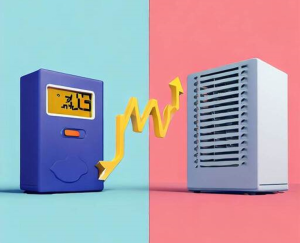Have you ever strolled into your home during the winter months and noticed a mildewed smell or dampness in the air? This can be caused by excess humidity, which not only creates an uncomfortable living environment but also promotes mould growth. A dehumidifier can be a lifesaver in these circumstances, but have you considered the cost of running one?
The cost of operating a dehumidifier can vary greatly depending on several factors, including wattage and energy price per kilowatt-hour. Before you decide to make a purchase, it holds significant importance to grasp and comprehend the associated costs thoroughly. This understanding confirms that you choose the most optimal and cost-effective option tailored to your specific conditions and requirements.
In this piece, we’ll explore what affects dehumidifier running costs and provide tips for keeping those costs under control. Whether you’re looking for advanced features like humidistats or simply want to clean filters regularly, we’ve got you covered with data-driven advice to help keep your home dry without breaking the bank.
What is the cost associated with operating a dehumidifier?

In light of your monthly bills, you’re likely curious about the slice of the pie that operating a dehumidifier takes up, aren’t you? To gauge this cost, you’ll need two figures: your energy rate and the dehumidifier’s wattage.
With energy prices capped at 27p per kWh, let’s crunch some numbers. A robust dehumidifier, pulling 20 litres a day at 480 watts, will use 0.48 kWh. That’s nearly 13p for each hour it runs.
A smaller unit, say, one that handles 12 litres daily at 157 watts, costs you about 4.5p per hour. Remember, dehumidifiers don’t run non-stop; they cycle on and off according to humidity levels, potentially saving you some coins.
Do certain dehumidifiers have a lower cost to run compared to others?

First things first, the straightforward answer to your very astute question: is absolutely yes! Dehumidifiers are like snowflakes in their operating cost diversity. Some models are akin to a thrifty monk, requiring barely a whisper of power to do their thing, while others can be hefty eaters, leaving a noticeable imprint on your electricity bill. The reason? It all comes down to things like technology, size, and efficiency ratings.
Let’s knit a cosy blanket of understanding around the concept of efficiency. Energy Star-rated dehumidifiers, for instance, have donned the cape of Efficiency Hero. They’re designed to wring out moisture from the air much more effectively, using less electricity than their non-rated counterparts. Over the course of their lifetimes, these energy-conscious contraptions can keep your wallet significantly plumper, delivering the same dry-as-toast results for a slice of the power cost.
Have you ever heard of a desiccant dehumidifier? Unlike their refrigerant-chugging relatives, these units employ clever moisture-absorbing materials to do their magic, often boasting lower power demands, especially in cooler conditions. That’s a win for those of us living in less tropical climates, or for spaces not keen on doing the sauna challenge.
Now, let’s not get all misty-eyed yet; the type of dehumidifier is just one part of the equation. Size matters too – and I’m not just talking about whether it can fit in the broom closet! Choosing the right capacity for the space you’re trying to dehumidify can be as crucial as choosing the right life partner. Too big, and you’re paying extra for unneeded power; too small, and it’s running an endurance marathon trying to keep up, pushing your power bill higher like a kite on a breezy day.
In essence, bring out your magnifying glass and don that detective hat when you’re in the dehumidifier market. Keep a keen eye out for Energy Star ratings, ponder upon the desiccant versus refrigerant debate and size up your space requirements.
What energy efficient characteristics should I consider when purchasing a dehumidifier?

When you’re on the hunt for a dehumidifier, zeroing in on one with top-notch energy efficient features can make a world of difference to your power bills. Look for models with an Energy Star rating, which means they’re certified to use less power for the same performance as non-rated units.
Another smart choice is a dehumidifier with a built-in humidistat. This feature allows the unit to automatically turn off when the desired humidity level is reached, saving electricity and reducing wear on the device.
Additionally, consider the size. Opting for a dehumidifier that’s appropriately sized for your space can prevent overworking and excessive energy use. Remember that an oversized unit isn’t just overkill; it’s also an overcharge on your energy bill.
Tips for lowering the cost of running a dehumidifier
You’ve got your energy-efficient dehumidifier—now, let’s talk about how you can further trim those running costs to a minimum.
First, use a hygrometer to monitor your home’s humidity levels—there’s no need to overwork the unit if the air’s already comfortable.
Secondly, maintain your dehumidifier by cleaning the air filter regularly; a clogged filter forces the machine to work harder, upping energy use.
Place it in the centre of the room or at least away from walls and furniture for optimal air circulation.
Consider running it during off-peak electricity hours if your utility company offers lower rates.
Lastly, don’t forget to close doors and windows when it’s operating to prevent humid outside air from sneaking in and increasing the workload.
Conclusion
In conclusion, the financial aspect of operating a dehumidifier is an essential consideration for maintaining a comfortable and healthy indoor environment. Understanding the impact on your monthly expenses and navigating through the spectrum of operating costs empowers you to make informed choices when selecting an appliance that suits your needs.
Consequently, by deploying energy-efficient practices and embracing cost-saving strategies, you can keep the moisture at bay without sending your electricity bill through the roof. It’s all about finding that sweet spot where efficiency meets affordability, ensuring a harmonious coexistence with your trusty dehumidifier.
Now, armed with a newfound understanding of dehumidifier running outlay, you’re well-equipped to make informed decisions that strike the perfect balance between a comfortable home and a friendly monthly utility bill.
Frequently Asked Questions
How Much Energy Does a Dehumidifier Use?
The amount of energy consumed by a dehumidifier is typically measured in kilowatt-hours (kilowatt-hour). This can range from around 0.5 kilowatt-hour to 1.5 kilowatt-hour per hour, depending on the dehumidifier model and its efficiency rating.
Will Using a Dehumidifier Help Reduce Humidity?
Yes, a dehumidifier can effectively reduce humidity levels in a space by drawing moisture from the air. This can help prevent issues such as condensation and mould growth.
How Much Does It Cost to Run a Dehumidifier?
The cost to run a dehumidifier can be calculated by multiplying the energy consumption per hour to run the device by the local price per kilowatt-hour of electricity. For example, if a dehumidifier uses 1 kilowatt-hour and the energy cost is 12p per kilowatt-hour, it would cost 12p per hour to run.
What Type of Dehumidifier is the Most Efficient?
Refrigerant dehumidifiers (or compressor dehumidifiers) are often considered the most efficient dehumidifier type, especially in warmer conditions. They work by cooling the air to condense moisture, making them effective in various conditions.

